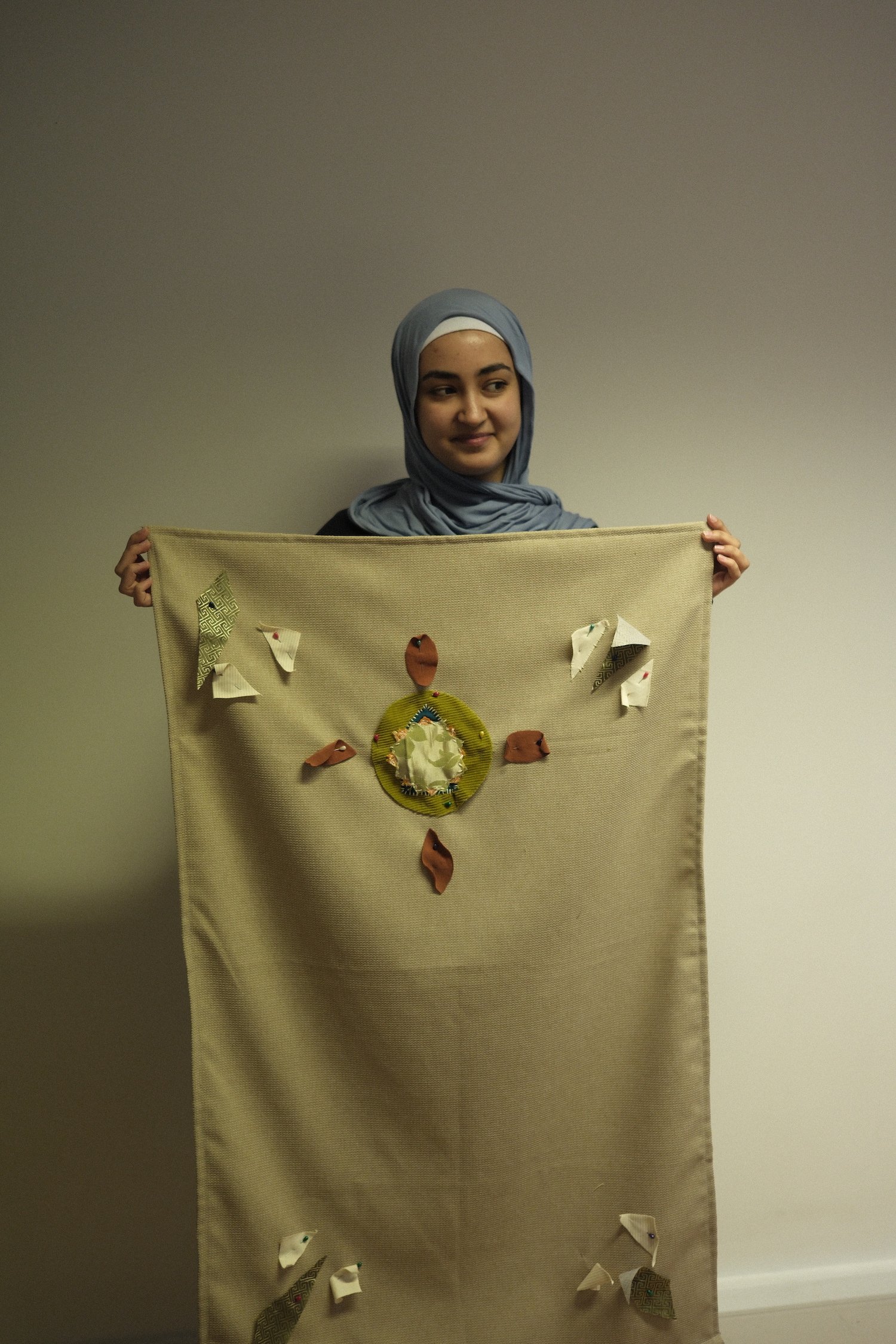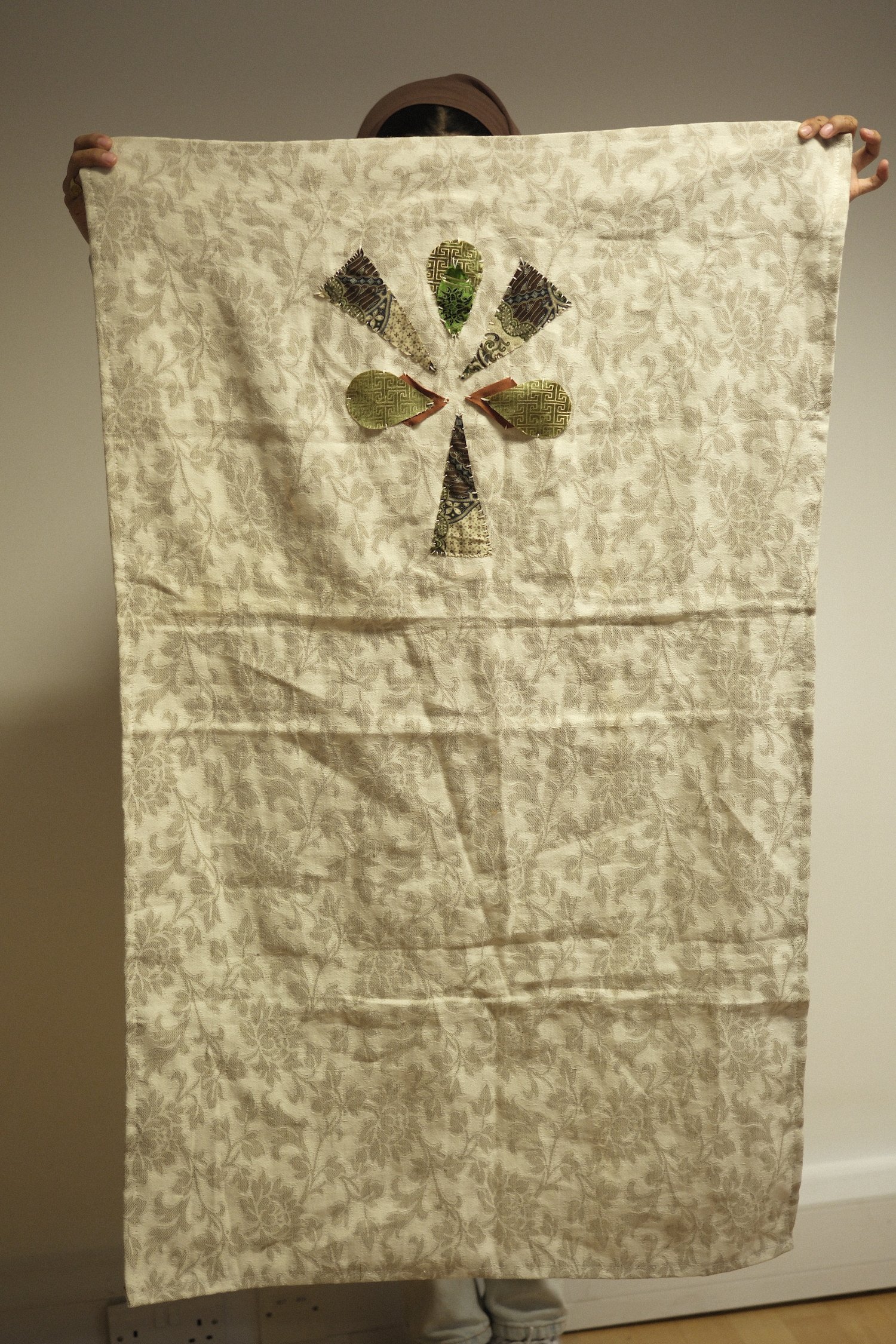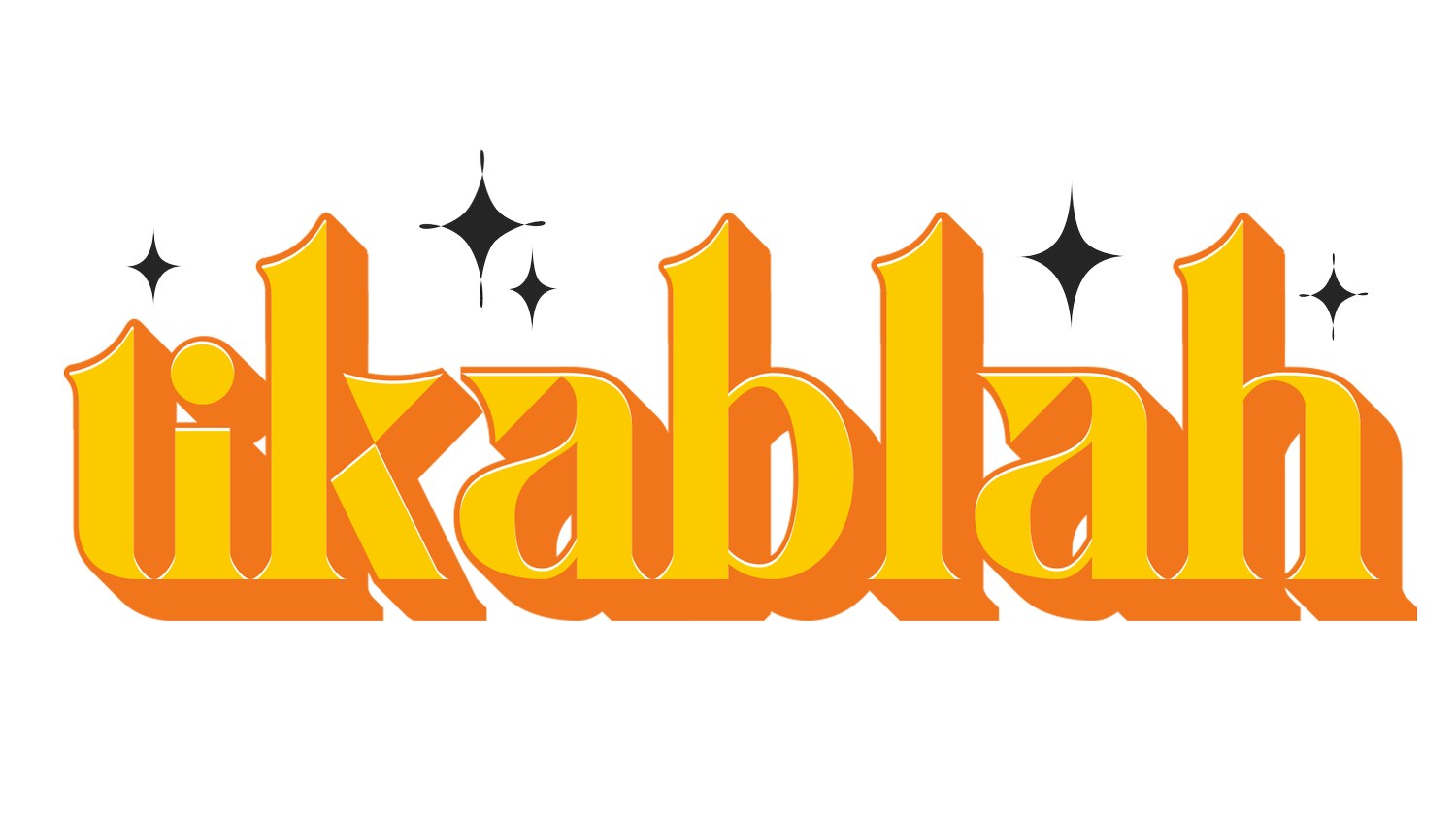UPCYLED SAJADA
Salah, or a prayer, is deeply intertwined with spiritual fulfilment and cultural identity for practising Muslims. Muslims usually use prayer mats for daily prayers. However, daily rituals relying on manufactured prayer mats raise sustainability concerns amid issues around material waste from production.
This PROJECT explored sustainable prayer mat design opportunities reflecting Islamic environmental ethics to address textile waste while meeting Gen Z and younger Millennial Muslims’ needs in the UK.
Category
Project Management, Creative Direction
Type
Collaborative Project
Project Outcome
Sustainable Prayer Mat, Service Design (Production System Map & Workshop Structure) and Branding Strategy & Identity
Year
2023
Collaborators
Forest Recycling Project, Jasmine Karis, Sustainably Muslim, Anisah Yaminah, Trisha Nadira, Raisa Larashati
A picture of prayer mats sold in Saudi Arabia (2023).Having grown up immersed in Islamic values in Indonesia, I developed a strong connection to the teachings of Prophet Muhammad [peace be upon him] about kindness and good deeds. Through engaging in community activities, I observed my Muslim friends diligently practising salah using prayer mats or carpets. Having previously sold prayer mats back home, I was curious about their immense significance as integral pieces used daily, indoors and outdoors. This sparked the idea of creating a prayer mat that would serve as a beneficial and ethical asset for Muslim communities here in London.
STAKEHOLDER MAPPING
50% of all Muslims in the UK belong to Gen Z or younger Millennial cohorts (aged 27 and under) (Office for National Statistics, 2023; Dimock, 2022).
75% of British Muslim (18-35 years old) said it’s important to have prayer mats and they feel a spiritual connection from using prayer mats (based on online survey from 52 participants).
PROBLEM DEFINITION
Diagram of how existing prayer mat production is contradictive with the concept of sustainability. The linear process (left side) is the combination of the process from 3 Muslim product brands (based on the my interviews) and standard fashion design process model from PLATE conference 2015 (Han et al., 2015).
The spiritual and practical significance of prayer mats for Muslims in Britain, where a growing population of Gen Z and younger Millennials (18-35 years old) practising Muslims in the UK prioritises sustainability. However, commonly available prayer mats rely on unsustainable materials like polyester, following an environmentally harmful linear production model that contradicts Islamic principles of avoiding waste and protecting nature’s balance. This disconnect between spirituality and sustainability in prayer mat production, fails to meet the needs of young, eco-conscious British Muslims seeking to integrate their faith and environmental values.
SUStainability & ISLAM
Islamic sustainability aligns with circular economy concepts emphasising waste and pollution reduction, material circulation, and ecological restoration. Both share the ethos to reuse and avoid resource wastage to foster harmony between humanity and earth. Circular design takes a holistic view beyond just recyclability, recognising materials embody time, energy and creativity better retained through reuse and remanufacturing rather than disposal (Ellen Macarthur Foundation, 2021).
RESEARCH QUESTION
How might we enable a practical change in a production process of prayer mats to address the lack of sustainability, in order to create a prayer mat that raises awareness of Islamic and sustainability values for Gen Z and younger Millennials practising Muslims (18-35 years old) in the UK?
AIM
To develop a design intervention that creates a more sustainable production process of prayer mats in the UK through upcycled materials, reflecting the concept of sustainability within Islamic values while fulfilling the needs of prayer mats and giving the awareness of sustainability values for Gen Z and younger Millennials practising Muslims (18-35 years old) to practice their salah five times a day.
RESEARCH FRAMEWORK
I combined two research frameworks - the systemic design framework by the Design Council (2021) and the triple diamond framework by TheyDo (n.d.). The systemic design framework was adopted to guide the design process towards sustainability, aligning with the project’s aim to integrate sustainability principles and Islamic teachings into the prayer mat lifecycle. Specifically, it allowed the exploration of circular textile strategies like upcycling and waste reduction. The triple diamond framework afforded more stages for iterative development compared to the conventional double diamond, as well as looping back. This proved helpful as I experienced shifts in plans during the research process.
FINDINGS
solution
DESIGN INSPIRATION
As donation was the most cited sourcing route in the main stakeholders’ interviews, I instituted a donation scheme with them and the researcher’s peers to gather materials for upcycling. Geometric shapes were designed from donated fabrics, inspired by the Prophet Muhammad’s hadith (Sahih Muslim 1397, n.d.).
“Do not undertake a journey to visit any Mosque, but three: this Mosque of mine, the Mosque of al-Haram and the Mosque of Aqsa (Bait al-Maqdis).” - Muhammad, narrated by Abu Hurairah.HOW TO DESIGN A PRAYER MAT?
See more of the sampling sessions here.
WORKSHOP EVENT
Focus on the purpose of the prayer, which is getting closer to God. Avoiding any distractive design is required (Sunan an-Nasa’i 771, n.d.).
The design should be focused on the concept of the Oneness of God. Hence, the design should be appropriate for praising Allah; meaning no aniconism and calligraphy taken from Qur’an verses (Syaykh ‘Abdul-‘Aziz bin ‘Abdullah bin Baz et al., 2002).
Materials used should be pure. Similar to the prohibition of what Muslims should eat, materials made from pig and blood are prohibited (Qur’an 2:173; Qur’an 5:3; Qur’an 6:145; Qur’an 16:115) as they contain impure elements.
When doing prostration, there should be seven parts of human’s body touching the ground (Sahih al-Bukhari 812, n.d.). Thus, the ground has to preferably still be felt during prostration and very thick materials can disrupt the purpose of the prostration.
PROJEct outcome
Four categories of design outputs based on Systemic Design Framework (Design Council, 2021).
VALUE PROPOSITION
Upcycled Sajada’s three core values using Venn Diagram (Jones + Waddell, 2019) and diagram of impact.
VISUAL BRANDING
The main output of the research was a creative prayer mat workshop, initially conceived as a user testing method. This workshop brought partners together for creative collaboration, emphasising the framework’s focus on convening stakeholders for united efforts. The resulting prayer mats represented the interconnectedness of participants, with the event space facilitating shared experiences, creativity, and community building.
The workshop was held on October 14, 2023, in Hoxton Works, with eleven 19-29 year old Muslim participants, including two men. Participants could freely design prayer mats based on individual preferences by choosing base materials and unused fabrics, and then applying the hand-stitching technique (appliqué). I prepared ample shape options and materials despite limitations. Participants chose between running and whip stitches for the beginner-friendly, as well as relaxing activity. Fabric glue, pins, and embroidery hoops were also available as options. Participants had 15 minutes to select materials and design, then 90-100 minutes to sew. The facilitator and collaborators assisted participants one-on-one as needed.










In developing the workshop, it became evident that clearly outlining event phases would enable seamless delivery and stakeholder coordination. The framework is divided into three areas: pre-workshop planning, during-workshop facilitation, and post-event follow-up. Distinct roles and actions represent each stage, necessitating collaboration across the timeline to actualise the workshop. Setting hypothetical time provides targets for initial milestones, resources, and partner alignments.
WORKSHOP STRUCTURE
PRODUCTION SYSTEM MAP
Follow Upcycled Sajada’s story on Instagram
Credits
Project Management
Tika Pratiwi Sufyan
Brand & Event Strategy
Tika Pratiwi Sufyan, Jasmine Karis
Workshop Organisation
Tika Pratiwi Sufyan, Jasmine Karis, Anisah Yaminah
Event Marketing
Tika Pratiwi Sufyan, Sustainably Muslim
Identity & Branding
Tika Pratiwi Sufyan, Raisa Larashati, Putri Nadhira
Stitchers
Jasmine Karis, Anisah Yaminah, Trisha Nadira
Tutor
Anna Nagele
“As caliphs on this shared home, our sacred duty is maintaining the balance gifted to us all by consuming within our means.”
— (Qur’an 2:30; Qur’an 7:31)
References:Coyle, M. (2022, February 21). 360k tonnes of reusable clothes are dumped in landfill each year. Greatest Hits Radio. https://planetradio.co.uk/greatest-hits/uk/news/fast-fashion-facts/ (Accessed: 26 May 2023).
Design Council. (2021). Systemic design framework. Make life better by design - Design Council. https://www.designcouncil.org.uk/our-resources/systemic-design-framework/ (Accessed: 19 October 2023).
Dimock. (2022, April 21). Defining generations: Where millennials end and Generation Z begins. Pew Research Center. https://www.pewresearch.org/short-reads/2019/01/17/where-millennials-end-and- generation-z-begins/ (Accessed: 26 May 2023).
Ellen Macarthur Foundation. (2022). Circular for fashion. Ellen Macarthur Foundation.
Ellen Macarthur Foundation. (n.d.). How to Build a Circular Economy | Ellen MacArthur Foundation. https://ellenmacarthurfoundation.org/ (Accessed: 5 September 2023).
Han, S. Tyler, D. Apeagyei, P. (2015). PLATE Conference 2015: Upcycling as a design strategy for product lifetime optimisation and societal change. Manchester Metropolitan University’s Research Repository. https://e-space.mmu.ac.uk/605265/1/PLATE%202015%20Upcycling%20Paper.pdf (Accessed: 22 May 2023).
Jami’ at-Tirmidhi 2417. Book 37, Hadith 3. English translation: Vol.4, Book 11, Hadith 2417. Available at: https://sunnah.com/tirmidhi:2417 (Accessed: 17 May 2023).
Jones + Waddell. (2019, August 29). How to identify your brand’s value proposition. Medium. https://medium.com/swlh/how-to-identify-your-brands-value-proposition-62611e6c59e4 (Accessed: 21 November 2023).
Office for National Statistics. (2023, January 30). Religion by age and sex, England and Wales. Home - Office for National Statistics. https://www.ons.gov.uk/peoplepopulationandcommunity/culturalidentity/ religion/articles/religionbyageandsexenglandandwales/census2021#religion-by-age (Accessed: 2 May 2023).
Qur’an. 16:115. Translated by Mustafa Khattab (2020). Bolingbrook, US: Book of Signs Foundation. Available at: https://quran.com/16?startingVerse=115 (Accessed: 3 June 2023).
Qur’an. 2:173. Translated by Mustafa Khattab (2020). Bolingbrook, US: Book of Signs Foundation. Available at: https://quran.com/2?startingVerse=173 (Accessed: 3 June 2023).
Qur’an. 5:3. Translated by Mustafa Khattab (2020). Bolingbrook, US: Book of Signs Foundation. Available at: https://quran.com/5?startingVerse=3 (Accessed: 3 June 2023).
Qur’an. 6:145. Translated by Mustafa Khattab (2020). Bolingbrook, US: Book of Signs Foundation. Available at: https://quran.com/6?startingVerse=145 (Accessed: 3 June 2023).
Qur’an. 7:31. Translated by Mustafa Khattab (2020). Bolingbrook, US: Book of Signs Foundation. Available at: https://quran.com/7?startingVerse=31 (Accessed: 3 June 2023).
Sahih al-Bukhari 812. Book 10, Hadith 207. USC-MSA web (English) reference: Vol.1, Book 12, Hadith 776. Available at: https://sunnah.com/bukhari:812 (Accessed: 4 September 2023).
Sahih Muslim 1397a. Book 15, Hadith 588. USC-MSA web (English) reference: Book 7, Hadith 3218. Available at: https://sunnah.com/muslim:1397a (Accessed: 25 November 2023).
Sunan an-Nasa’i 771. Book 9, Hadith 30. English translation: Vol.1, Book 9, Hadith 771. Available at: https://sunnah.com/nasai:771 (Accessed: 31 August 2023).
Syaykh ‘Abdul-‘Aziz bin ‘Abdullah bin Baz, Syaykh Muhammad bin Salih Al-‘Uthaimin, Syaykh ‘Abdullah bin ‘Abdur-Rahman Al-Jibreen. (2022) Fatawa Islamiyah: Islamic Verdicts. Riyadh: Darussalam: Global Leader in Islamic Books. Available at: https://www.kalamullah.com/Books/Fatawa-Islamiyah-Islamic-Verdicts-Vol.-4.pdf.
TheyDo. (n.d.). User-friendly journey management. Collaborate Around Customer Journeys | TheyDo. https://www.theydo.com/guides/intro-to-the-journey-management-workflow (Accessed: 19 October 2023).







































